Isabella Bradford's Blog, page 3
November 8, 2018
Friday Video: Getting Dressed in 1816
Susan reporting,
Another wonderful video from our friends at CrowsEyeProductions - and this one also tells the story of how author Mary Shelley came to write her legendary novel Frankenstein. Many people believe that women's clothing of the early 19thc was breezy and uncomplicated. In comparison to the more structured clothing of the 18thc, perhaps it was; but as this video showed, there were still a good many layers involved, and a lady's maid continued to be useful.
Many thanks to Pauline Loven for sharing the latest in the "Getting Dressed" series with us.
If you receive this post via email, you may be seeing a black box or empty space where the video should be. Please click here to see the video.
Published on November 08, 2018 21:00
November 7, 2018
Armistice Day One Hundred Years Later
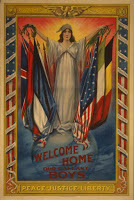 Welcome Home Our Gallant Boys
Loretta reports:
Welcome Home Our Gallant Boys
Loretta reports:Sunday marks the 100th anniversary of the signing of the Armistice ending World War I—known as the Great War and the War to End War, until only a couple of decades later, when another great war broke out.
World War I was a horrendous war , even by war’s horrendous standards, as Wilfred Owen’s poetry makes more than clear. His war isn’t heroic or romantic. It’s ghastly and heartbreaking. For a time, his work fell out of favor for this reason. But only for a time.
An English professor introduced me to "Anthem for Doomed Youth" fifty or so years after it was written, at a time when it struck a chord with those protesting the Vietnam War. Owen’s and others’ poetry led me, some years later, to Robert Graves’s Good-Bye to All That , which offered insights into both the war and that generation of Englishmen. Unlike Owen, Graves survived.
For me, these works and others began an education that continues. Visits to English and Scottish churches, stately homes, and memorials have given me a powerful sense of the toll this particular war took on the other side of the Atlantic.
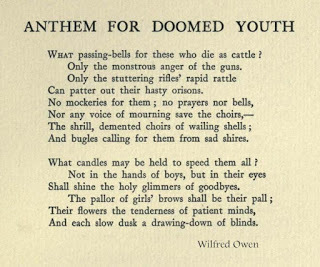 Anthem for Doomed Youth 1917
Anthem for Doomed Youth 1917
We keep hoping, but so far, no war has ended war. All we seem to be able to do is mourn and remember. The Tower of London remembers, beautifully and movingly, again this year, as you will discover if you search “Beyond the Deepening Shadow,” for images from the centenary commemoration.
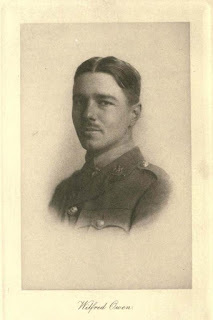 Wilfred Owen
Wilfred Owen
Images: Welcome Home Our Gallant Boys , 1918 poster, courtesy courtesy Library of Congress Prints and Photographs Division Washington, D.C. 20540 USA; "Anthem for Doomed Youth" and photograph of Wilfred Owen from Poems by Wilfred Owen , 1920.
Clicking on the image will enlarge it. Clicking on a caption link will take you to the source, where you can learn more and enlarge images as needed. And, just so you know, if you order a book through one of my posts, I might get a small share of the sale.
Published on November 07, 2018 21:30
November 5, 2018
Election Day
 No blog post today, except this one-word message for our American readers.
No blog post today, except this one-word message for our American readers.You know what to do, right?
Vote, published by the Milwaukee County League of Women Voters, early 20thc, Collection of the Wisconsin Historical Society.
Published on November 05, 2018 21:00
November 4, 2018
Fashions for November 1913
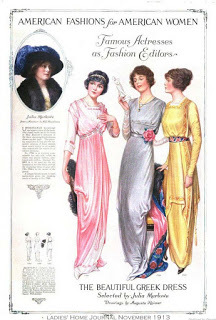 Dresses November 1913
Loretta reports:
Dresses November 1913
Loretta reports:Let's read over the shoulder of a lady in 1913 who's just picked up the latest copy of Ladies Home Journal.
What I See on Fifth Avenue by Alice Long: With Drawings by Jessie Gillespie.
“From the top of one of those lumbering, top-heavy busses that wheeze ponderously along Fifth Avenue is really the best place to get a good view, not alone of the shops that line the avenue, but also of the kaleidoscopic mass of color formed by the hurrying streams of woman shoppers. And if you are looking for what is new in fashion you are just as apt to see it on some of these same shoppers, many of whom have names that are household words because of their prominence socially or because of the financial rating of their men folks, as in even the most exclusive shops...
“I SPENT several days going through the more important Fifth Avenue shops and dressmaking places, and of one thing I am convinced: The fashionable silhouette demands fullness at the hips and a narrowing in at the foot; and be it peplum or tunic—call it what you please—some sort of flounce arrangement must be shown on the skirt of a fussy dress anywhere between the waistline and the feet. A strikingly pretty model of this sort of composite type formed the dress of one of the season’s débutantes, and was intended for a luncheon to be given in her honor. It was of a dull watermelon pink shade of silk crepe, with a. blouse of pale lilac chiffon over flesh-colored malines.* The Medici frill is wired with fine silk wire, so fine as to be invisible, and the plaited tunic, which is of the lilac chiffon, is also wired on the edge, so that it stands out the tiniest little bit.—Ladies’ Home Journal, Volume 30, November 1913
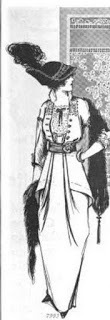 The whole article is an interesting read: the color red's popularity, the puzzle of wearing summer weight fashion in November and heavy fabrics in summer, etc.
The whole article is an interesting read: the color red's popularity, the puzzle of wearing summer weight fashion in November and heavy fabrics in summer, etc.*Malines in this context appears to refer to "Malines Lace—Bobbin lace with sprigs or dots outlined with a heavier cordonnet over a hexagonal or round mesh ground. It is made in one piece of white flax thread."— Dictionary of Textiles , Harmuth 1915. Aka Mechlin Lace. You can read a history of lace here .
Clicking on the image will enlarge it. Clicking on a caption link will take you to the source, where you can learn more and enlarge images as needed.
Published on November 04, 2018 21:30
November 3, 2018
Breakfast Links: Week of October 29, 2018
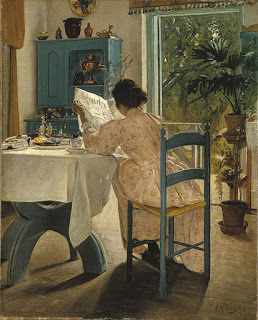 Breakfast Links are served! Our weekly round-up of favorite links to other web sites, articles, blogs, and images via Twitter.
Breakfast Links are served! Our weekly round-up of favorite links to other web sites, articles, blogs, and images via Twitter.• Does discovery of a red velvet bag reinforce the legend that Sir Walter Raleigh's widow Elizabeth kept his severed head with her after his execution?
• R is for raisins , the unexpected super-food found in many early modern medicines.
• Norah Smyth , suffragette photographer.
• Image: Cat passages in the doors at Thomas Jefferson's 18thc Monticello .
• The 19thc angel guides of death.
• Stylish (and prize-winning) 1959 dress , made from a feedsack.
• President George Washington's letter to the Hebrew congregation in Newport, RI, 1790.
• Image: Dubious tips on how to get a husband from an 1950s women's magazine.
• " Knackers pork ": the grim reality of London slaughterhouses during the Regency.
• Elizabeth Thorn , the angel of the Battle of Gettysburg.
• Wheat the old way: 1940s video of Pennsylvania Dutch family harvesting wheat by hand, without modern machinery.
• From an 1930s trousseau : beautifully embroidered silk slip and tap pants.
• Image: 1850s child's leather boot decorated with a black cat.
• A Mandarin duck mysteriously appears on a pond in New York's Central Park.
• John Rogers and "The Legend of Sleepy Hollow ."
• The Kit-Kat Club , an 18thc literary, political, and social club that became a stronghold of the Whig party.
• Workers in a Goodwill store in New Jersey discover an important, original 1774 Philadelphia "rebel" newspaper .
• Fifteen important women in history that you may not have heard of.
Hungry for more? Follow us on Twitter @2nerdyhistgirls for fresh updates daily.
Above: At Breakfast by Laurits Andersen Ring. Private collection.
Please note: I'll be traveling this week, so alas, no Breakfast Links next Sunday....
Published on November 03, 2018 14:00
November 1, 2018
Friday Video: The Two-Handkerchief Bra, 1921
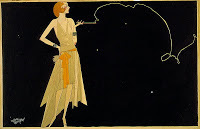 Courtesy Library of Congress
Courtesy Library of CongressLoretta reports:
In the early days of the brassiere, two handkerchiefs would do, apparently. Here's how to turn them into an undergarment.
Illustration Where there's smoke there's fire, Russell Patterson, 1920s. Courtesy Library of Congress Prints and Photographs Division Washington, D.C. 20540 USA
Published on November 01, 2018 21:00
October 31, 2018
Rare Survivors in New York City: Sylvan Terrace's Cobblestones & Row Houses, c1880

Susan reporting,
When most of us think of Manhattan, we picture towering skyscrapers, sleek walls of glass and stone, midtown streets crowded with cabs, cars, and bustling pedestrians. Small 19thc wooden row houses and a quiet cobble street: not so much.
Yet the street shown here is indeed in Manhattan, in Washington Heights near 160th Street. I discovered it by accident, on my way to visit the 18thc Morris-Jumel Mansion (more about that in a later post.) No matter where you live, the scene may look familiar, because it has appeared as a location in numerous period films.
The street is called Sylvan Terrace. In the 1880s, the city's growth was creeping uptown, and the open fields and gardens that had so long insulated the Morris-Jumel Mansion were finally being divided into streets and house-plots. Developer James E. Ray commissioned twenty identical row houses, built on what had once been the Mansion's carriage drive. Because the neighborhood was so far uptown from what was considered the "city," the houses were exempt from fire codes that stipulated brick or stone construction, and could instead be made from less expensive wood over high brick basements.
The new street was given the pastoral name of Sylvan Terrace, another indication of how far it still was from downtown. The houses were modest, and the residents were middle-class, tradesmen and small merchants. The neighborhood continued to grow around them, larger and more lavish brownstone townhouses followed by larger-still apartment buildings. In a city where buildings are routinely knocked down within a generation to build something new, all twenty of the little frame houses on Sylvan Terrace miraculously survived.
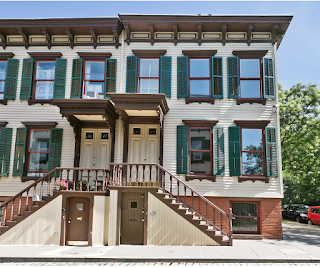
But time did bring changes. The original cobblestones were paved over with asphalt, and the houses themselves gradually lost most of their wood trim. Some were fronted with stucco facades, others sheathed in aluminum siding or false brick. The basic integrity of the street remained, however, and in 1970, the city's Landmarks Preservation Commission created the Jumel Terrace Historic District.
In 1981, Federal funds restored the facades to approximate their original unified appearance; the backs of the houses still reflect 20thc remodeling. The asphalt paving was removed from the cobblestone street. Reaction to the restoration seems to have been mixed at the time. Residents complained that the work had been shoddy, and a few rebellious owners began repainting the new facades. In an 1989 article about the restoration, The New York Times deplored its "deadened homogeneity."
Visiting today, it appears that the disgruntlement of the 1980s has been forgotten, or at least put aside. The houses appear beautifully maintained, and unified in their color schemes - which I personally found more harmonious than homogeneous. Perhaps it's not so much a matter of taste, but economics, that has brought peace to Sylvan Terrace. The houses seldom come on the market, but when they do, their charm and history come at a price: $1,500,000 and up.
Above: Photograph by Susan Holloway Scott.
Lower right: Photograph via Curbed NY.
Published on October 31, 2018 21:00
October 30, 2018
The Vision of Skulls—a Little Rowlandson for Halloween
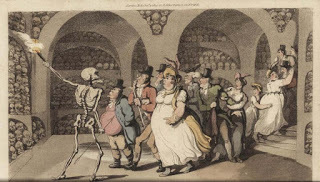 Rowlandson,
The Vision of Skulls
Loretta reports:
Rowlandson,
The Vision of Skulls
Loretta reports:Halloween seems an appropriate time for an excerpt from The English Dance of Death . In this volume, Thomas Rowlandson takes on a popular artistic subject, focusing on his countrymen, with William Combe writing a narrative based on the pictures (the method they used in the Tour of Doctor Syntax). In this excerpt from “The Vision of Skulls,” Sir Thomas describes a dream to his wife.
—The Phantom gave three heads a stroke
With his fierce Torch, and thus they spoke.
—Said one, "I was a soldier brave,
Who found in war an early grave;
But, e'er in Honour's field I died—
I slew the Hero by my side."
The Hero, by his side, exclaim'd,
—" 'Twas my right arm your prowess tam'd:
It was my sabre's well-aim'd blow,
That laid your glittering figure low."
"Ho," cried a third, "pray cease your pother,
I saw you both kill one another."—
—Thus, though no arms, or legs had they,
I thought they threaten'd an affray;
And seem'd, without alarm or dread,
To long to play the Loggerhead.
I thought their clamour ne'er would cease:
But the Torch wav'd, and all was peace.
It seem'd most strange the sight I saw,
That heads should speak 'gainst Nature's law,
Without a Tongue,—nor move a Jaw.
'I humbly told the Guide, that I Was of the class of Chivalry.
But that I was a Civic Knight,
Who had much rather eat than fight.
—Turn and look up, methought he said,
At the huge Sculls above your head,
Which are so thick, they might defy
The balls of any musketry.
Those which there meet your curious ken,
Belong'd to Knights and Aldermen,
Who to the Sword's heroic work
Preferr'd the feats of Knife and Fork;
And, as they grin, the Jaws between,
Their well-us'd, worn-out teeth are seen.—
But all these mortal remnants stood,
In such exact similitude,
I could not see, with all my care,
If any of my friends were there.
—I then enquir'd, if no offence,
And hop'd 'twas not impertinence,
If he might tell whose fleshless face
Was to fill up an empty space,
Which seem'd so large, that I could swear,
It was preserv'd for some Lord Mayor.
He wav'd his Torch, and lost in smoke,
'Twas thus I thought the Spectre spoke.—
—That place, Sir Simon, is your due:
And shortly will be filled by you.—
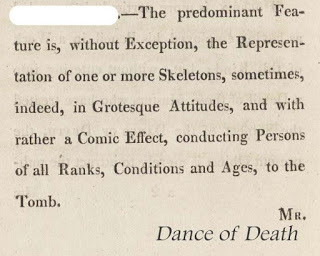 Intro to English Dance of Death
—
The English Dance of Death
, From the Designs of Thomas Rowlandson with Metrical Illustrations, by the Author of “Doctor Syntax.” Vol 1 (1815)
Intro to English Dance of Death
—
The English Dance of Death
, From the Designs of Thomas Rowlandson with Metrical Illustrations, by the Author of “Doctor Syntax.” Vol 1 (1815)Images: The Vision of Skulls
Excerpt from introduction to The English Dance of Death
Clicking on the image will enlarge it. Clicking on a caption link will take you to the source, where you can learn more and enlarge images as needed.
Published on October 30, 2018 21:30
October 29, 2018
Embroidery as the Thread of History
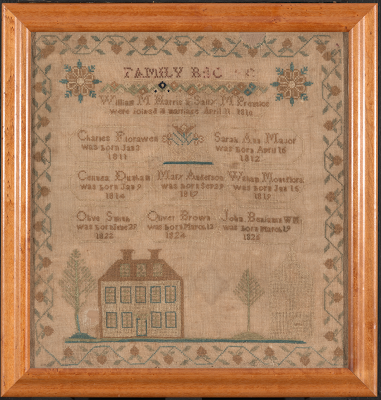 Susan reporting,
Susan reporting,In the modern era, examples of amateur needlework created by women and girls of the past have often been regarded as sweetly decorative, and no more. The notion of dainty feminine hands bent over a sampler is a romantic one that's hard to shake: tiny precise stitches simultaneously represented not only industry, but also the luxurious spare time to sit and embroider with costly materials. While there is certainly an element of truth to this, the admiration can also be tinged with condescension. Boys went out into the world and did important things. Girls sat sequestered indoors and stitched pretty pictures.
Lately, however, material culture scholars have begun to study samplers and other embroidery from a different perspective. A new exhibition at Winterthur Museum called Embroidery: The Thread of History (now through January 6, 2019) considers these embroidered pieces as historical documents that described not only the workers themselves, but their families, friends, and the world in which they lived. As the catalogue notes, "Women are often poorly represented in traditional archival sources, but their needlework can provide crucial evidence of lives that would otherwise remain unknown."
Eighteenth and early nineteenth century samplers that listed the maker's hometown and her birth date as well as the dates for other family members were regarded as important family documents. They held the same importance and legitimacy as the handwritten pages in the front of family Bibles, and in an era when many families were moving to new regions, a sampler could be more lasting and more portable than a Bible page, too. Samplers noting marriages and births were even accepted as evidence in the military pension applications presented by widows of Revolutionary War veterans.
Through their needlework, women and girls could evoke a familiar place or culture left behind through emigration, or display civic pride by showing a new local town building or church. They could document the family's trade or wealth, documenting ships, farmlands, and homes. They could memorialize and honor the dead, whether a family member or a national figure like George Washington.
Needlework could also represent a much larger history, as the exhibition notes for the family sampler shown above - worked in silk on linen by Sarah Ann Major Harris as a schoolgirl c1822-1828 - explain:
"This sampler documents an extraordinary family and foreshadows the legal fight for equal rights for African Americans. Seeking to further education in order to become a teacher, Sarah Ann Major Harris (1812-1878) , asked Prudence Crandall if she could become a day student at her school in Canterbury, Connecticut, in 1832. Crandall agreed and, in protest, many parents withdrew their daughters from the school. Crandall then recruited other young black female pupils, many of whom were from out of state. As a result, the state of Connecticut adopted what became known as the Black Law, which prohibited the teaching of 'Colored persons who are not inhabitants of this state.' The arguments developed by Crandall's defense attorneys were used later in the case of Dred Scott vs. Sanford (1857) and were echoed in Lincoln's Emancipation Proclamation.
"Sarah Harris continued to be active in the abolitionist movement throughout her life. She married another activist, George Fayerweather, and today their home in Kingston, Rhode Island, is listed on the National Register of Historic Places. Sarah was clearly well educated, having worked this sampler before attending Crandall's school."
Many thanks to Linda Eaton, Director of Museum Collections and Senior Curator of Textiles, Winterthur Museum, for her assistance with this post.
Above: Sampler, worked by Sarah Ann Major Harris, possibly at a school in Saybrook, CT, 1822-28. Winterthur Museum.
Published on October 29, 2018 18:57
October 27, 2018
Breakfast Links: Week of October 22, 2018
 Breakfast Links are served! Our weekly round-up of favorite links to other web sites, articles, blogs, and images via Twitter.
Breakfast Links are served! Our weekly round-up of favorite links to other web sites, articles, blogs, and images via Twitter.• Madhouse genetics : what the archives of mental-health asylums reveal about the history of human heredity and he evolution of genetics.
• A very fancy 18thc tradecard for a less-than-fancy trade: a nightman is a disposer of human waste.
• Photo sleuths : How an American Civil War soldier's photograph with distinctive markings reveals the forgotten, invaluable work of the Dead Letter Office.
• Divining Mother Shipton, the 15thc Witch of York: propaganda and prophecy.
• Image: The wig of Princess Nany , with locks set with beeswax and a wreathe of lotus leaves, c1000BC.
• Frivolous spending, private parties, and grumpy governesses: the secret lives of the servants at Chatsworth , the country seat of the Dukes of Devonshire.
• The mighty effects of spiritous liquor displayed; or, 18thc cider was a temperance drink.
• Image: Dandy! Painter George Harvey looking dashing in his patterned dressing gown over waistcoat and trousers, c1840s, plus a similar surviving dressing gown.
• Beautiful and haunting photographs: tales from the valley that time forgot.
• The great big pumpkin fight: a late 19thc symbol of the growing divide between rural and urban American life.
• Victorian mourning jewels and how they were worn.
• Too many apples? Follow this 18thc recipe to make a marmalet of pippins .
• Image: Two child-sized armchairs with petit-point covers worked by Alice B. Tolkas from designs by Pablo Picasso.
• Bright 19thc embroidered braces : worked by wives, daughters, and sweethearts to help keep men's trousers in place.
• Where to find remnants of the glorious old Penn Station in New York City.
• An A-Z of Victorian novel deaths .
• Historic hauntings from Hampton Court palace.
• Saved by a giant turtle? A roadside marker program in the state of New York embraces the grey area between official history and Hungry for more? Follow us on Twitter @2nerdyhistgirls for fresh updates daily.
Above: At Breakfast by Laurits Andersen Ring. Private collection.
Published on October 27, 2018 14:00



